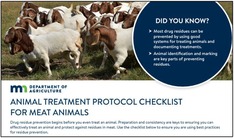
2019-2021 Minnesota Statewide Acute Care Antibiograms Now Available
An antibiogram is the compilation of antimicrobial susceptibilities of selected pathogens isolated from a specific human or animal population. Antibiograms can serve as valuable tools in guiding therapy choices.
The annual Acute Care Statewide Antibiogram was made for the years 2019-2021 and is available at Minnesota Antibiotic Stewardship Data. During the timeframe, there was an increase in the number of submitted antibiograms from 41 to 61, leading to better representation of acute care Minnesota hospitals. While there were some changes noted in susceptibility patterns, the majority were not consistent over the time frame or had minimal clinical significance due to the standards already implemented in prescribing practices by most providers.

CDC Releases New Antimicrobial Resistance (AR) Threats Data
In July 2024, CDC published Antimicrobial Resistance Threats in the United States, 2021-2022. Using new data, CDC updated the U.S. burden of seven antimicrobial-resistant pathogens typically found in health care settings. These new data show that AR increased by a combined 20% during the COVID-19 pandemic compared to the pre-pandemic period, peaking in 2021, and remaining above pre-pandemic levels in 2022.
In addition, the number of reported clinical cases of C. auris—a type of yeast that can spread in health care facilities, is often resistant to antifungal medications, and can cause severe illness—increased nearly five-fold from 2019 to 2022. These data show that additional action is critical to slow the spread and impact of antimicrobial resistance.
AVMA Updates Antimicrobial Policies
The American Veterinary Medical Association (AVMA) has updated two of its policies concerning the judicious therapeutic use of antimicrobials and endorsed a joint statement from the American Association of Bovine Practitioners and Academy of Veterinary Consultants on the therapeutic use of medically important antimicrobials in cattle. Read more at AVMA updates antimicrobial policies.
CDC Study Highlights COVID’s Impact on Infection Control, Multidrug-Resistant Pathogens in U.S. Hospitals
A new study by CDC researchers illustrates the impact that the COVID-19 pandemic had on infection control (IC) practices in U.S. hospitals, even in parts of the country that experienced lower SARS-CoV-2 transmission.
The study, published in the American Journal of Infection Control, describes outbreaks of emerging multidrug-resistant organisms (eMDROs) in 18 health care facilities in 10 states over the course of the pandemic. Survey results from the facilities indicate that changes in IC practices linked to the pandemic—along with shortages of and strategies to conserve personal protective equipment—may have contributed to eMDRO transmission.
To read a summary of the study and access the full article, visit CDC study highlights COVID's impact on infection control, multidrug-resistant pathogens in hospitals.
New APIC Council Dedicated to Veterinary Medicine Infection Prevention and Control
The Association for Professionals in Infection Control (APIC) has been a long-standing professional organization for infection preventionists (IPs) working in human health care. They currently provide a space for community engagement and networking, resources, education, and certification for IPs in human health care. Starting in August this year, APIC will also begin supporting and assisting to advance the field of veterinary infection prevention and control (IPC) by creating a veterinary medicine IPC council. This will give veterinary staff working in IPC, a central location to share resources, collaborate to improve guidance and research, and network.
The vision of the council is for professionals who work in all aspects of veterinary medicine and animal health to advance the science of veterinary IPC and biosecurity, promote and support One Health interprofessional collaboration, and assist and support colleagues working in veterinary IPC. This will cover all animal care disciplines and facilities including small and large companion animal clinics/hospitals, zoos, shelters, and sanctuaries as well as production animal, wildlife rehabilitation, research, education, public health, and human health care facilities that allow animal visitation.
The new council will be led by Leslie Kollmann, BS, AAS, CVT, CIC, veterinary infection preventionist with the MDH Zoonotic Diseases Unit and Regina Wagner, BSN, JD, RN, infection prevention manager for the Matthew J. Ryan Veterinary Hospital at the University of Pennsylvania School of Veterinary Medicine.
APIC members can join the council at no cost. If you are not a current APIC member and would like to join the council, go to https://apic.org, sign up, and for a limited time, APIC is offering a discount code for new vet IPC members. Use the code “VETIPC” for the discount. If you have questions regarding the new council or APIC membership, please reach out to Leslie Kollmann at leslie.kollmann@state.mn.us.
New Resources Available for Youth Livestock Exhibitors from 4-H and Minnesota Department of Agriculture

The Minnesota Department of Agriculture teamed up with 4-H this spring to create a bundle of resources for livestock exhibitors. This bundle pulls together antibiotic stewardship resources that our Drug Residue Prevention Team has developed over the past seven years. We hope our bundle is just a starting point and can be re-worked each year to meet the needs of 4-H and other organizations who support youth in agriculture.
You can access the bundle at MDA: Drug Residue Prevention Resource Library for Youth in Agriculture.
|

MDH MDRO Webinar Series
MDH will present a series of webinars on multidrug-resistant organisms (MDROs) including carbapenemase-producing organisms and Candida auris. Discussion and topics will vary by webinar and will include the containment strategy, organism information, annual case counts, case studies, enhanced barrier precautions, and discussions of MDRO screening. Webinars aim to be highly interactive and will provide time for questions.
Upcoming webinars:
The intended audience includes congregate settings such as long-term care and assisted living providers, including infection preventionists, directors of nursing, and interested health care staff.
Nursing CEUs will be provided to those who attend the webinar.
|